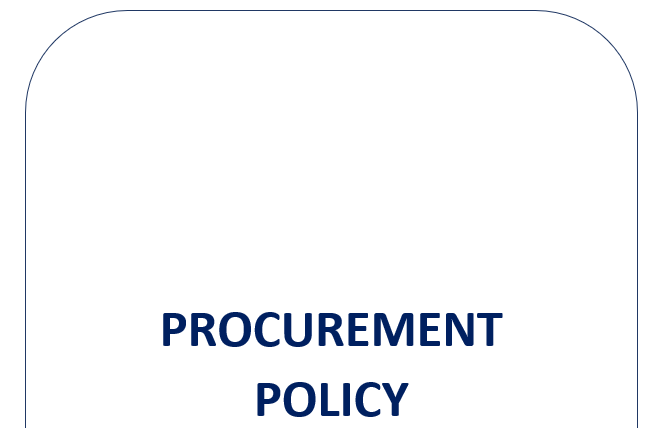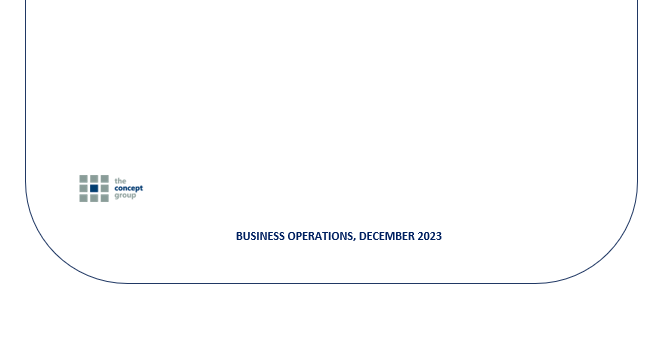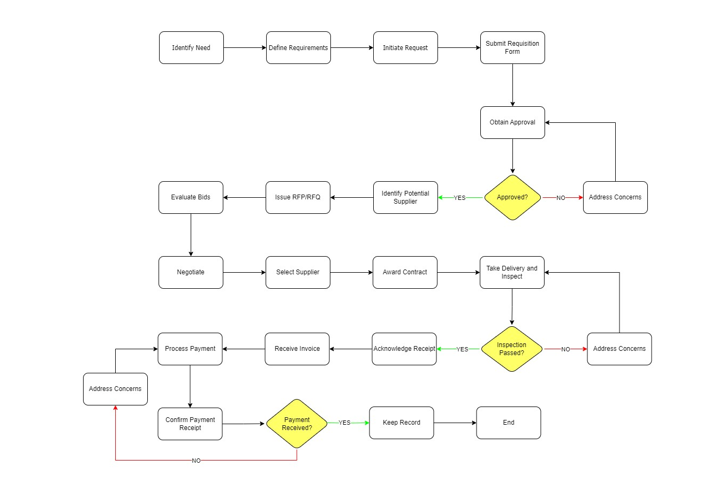PROCUREMENT POLICY
TABLE OF CONTENT
1.0 Introduction.……………………………………………………………………………………………………………………………………..4
2.0 Policy Statement……………………………………………………………………………………………………………………………….4
3.0 Scope……………………………………………………………………………………………………………………………………………….4
4.0 Objectives………………………………………………………………………………………………………………………………………...5
5.0 The Procurement Process………………………………………………………………………………………………………………...6
5.1 Process Details……………………………………………………………………………………………………………………………....6
5.2 Procedure for Staff and Departments Requesting Routine Items…………………………………………….….10
5.3 Procedure for Foreign Purchasing…………………………………………………………………………………………...….10
6.0 Vendor Management………….…………………………………………………………………………………………………………..12
6.1 Sourcing……………………………….……………………………………………………………………………………………..……….12
6.2 Onboarding……………………………….………………………………………………………………………………………….....….13
6.3 Management and Performance Evaluation………………………………………………………………………….....…..13
7.0 Delays………………………………………………………………………………………………………………………………………..……14
8.0 Returns……………………………………………………………………………………………………………………………………..…….15
9.0 Approval Chain and Limit………………………………………………………………………………………………………...…….18
10.0 Cancellation of Contract…………………………………………………………………………………………………….....……..18
11.0 Addendums and Extensions………………………………………………………………………………………………...………19
12.0 Deviations……………………………………………………………………………………………………………………………………19
13.0 Conflict of Interest and Conflict Resolution…………………………………………………………………………......…19
13.1 Conflict Resolution……………………………………………………………………………………………………………...……20
14.0 Stock Taking………………………………………………………………………………………………………………………….……..20
15.0 Ownership and Enforcement……………………………………………………………………………………………………….20
15.1 Compliance and Enforcement…………………………………………………………………………………………………..20
15.2 Legal and Regulatory Compliance……………………………………………………………………………………..……..20
16.0 Risk Management………………………………………………………………………………………………………………………..21
17.0 Policy Controls…………………………………………………………………………………………………………………………….21
18.0 Separation of Duties…………………….…………………………………………………………………………………………..…22
19.0 Policy Review and Update……………………………………………………………………………………………………….....23
20.0 Version History……………………………………………………………………………………………………………………………23
21.0 Stakeholders’ Concurrence………………………………………………………………………………………………………....23
22.0 Appendices……………………………………………………………………………………………………………………………...….24
1.0 INTRODUCTION
The Concept Group (TCG) procurement policy has been prepared to assist the vendor community in understanding how to do business with TCG.
TCG is one of the largest providers of financial and technical assistance in Nigeria.
All procurement of goods, works or services by subsidiaries of TCG deserves the highest degree of public trust and must be conducted within the standards of global best practice.
The procurement unit is responsible for all procurement activities of TCG. Essentially working as a service unit, the procurement unit serves as a coordinator between the requester and the supplier. The procurement unit must follow this manual in discharging their duties and adhere to thorough purchasing practices. The procurement unit currently resides in the Internal operations department.
2.0 POLICY STATEMENT
This Procurement Policy serves as a foundation for maintaining high standards of professionalism, ethics, and efficiency in the processes involved in the purchase of goods and services for the use of the organization (TCG). All staff members are expected to familiarize themselves with and adhere to the principles outlined in this policy.
This policy shall serve as a guide to all staff engaged directly or indirectly in the procurement of goods, works and services to ensure that best practice, efficiency, effectiveness, economy and competitiveness are achieved.
All departments / entities are free to contact the procurement unit when in doubt about purchasing procedures. Instructions will be made available on the handling of orders or problems. The essence of this is to prevent errors and mix-ups due to improper handling.
3.0 SCOPE
This document covers the processes in the following areas:
• Material Services.
• Contract Servicing.
• Foreign purchasing.
It also contains samples of the purchase requisition form, letter for contract award and contract service agreement.
4.0 OBJECTIVES
The objective of this policy are as follows:
• Effective and efficient service delivery to all departments
• Ensures the organization gets value for every naira spent.
• To buy the project and company’s required materials, components, machineries, industrial equipment, consumables, services in the required quantity at the most advantages price and economic cost.
• To address potential delay in obtaining delivery.
• To build up supplier goodwill by such means as fair dealing, the provision of cooperation and assistance and ensuring prompt payment
• To clearly define how purchases are made.
5.0 THE PROCUREMENT PROCESS
5.1 PROCESS DETAILS
1. Identify Need:
The procurement officer or user department/requester identifies a need within the organization or department. This could be a request for goods, services, or both.
2. Define Requirements:
The procurement officer or user department/requester clearly defines the requirements for the goods or services. This may involve collaboration between the procurement team and the end-user(s) to ensure that the specifications are accurate and comprehensive.
3. Initiate Request (Requisition Form):
Once a need is identified, the procurement officer or user department/requester uses a requisition form to formally initiate a request for the purchase of the required items or services. The requisition form includes details such as the description of the items, quantity, specifications, delivery requirements, and any other relevant information. The form is to be signed by the requester and the head of department requesting the item or service.
4. Submit Request (Send Requisition Form to Procurement Department):
The completed requisition form is then emailed to the procurement unit. This unit is responsible for managing and overseeing the procurement process.
5. Obtain and Get Approvals:
The procurement officer forwards the requisition form to the internal audit department to investigate the need for that item or service. The head of the internal audit team will append their signature to the requisition form to indicate that the need for that item or service is justified.
o For routine items or services, skip to step 6.
o Extra-budgetary items/services will be sent to the GM for final approval before going to step 6.
6. Identify Potential Suppliers:
The procurement officer researches and identifies potential suppliers who can meet the specified requirements. This would involve get information from the potential vendors regarding the item or service to be purchased. These vendors may be those currently registered or new vendors. The procurement officer is advised to source for new vendors from time to time in order to compare prices with the current vendors.
7. Issue a Request for Proposal (RFP) or Quotation (RFQ):
Based on the information received in the previous step, the procurement officer issues an RFP or RFQ to the selected suppliers. This document outlines the detailed requirements, evaluation criteria, and terms and conditions.
8. Receive and Evaluate Bids/Proposals:
On receipt of bids or proposals from interested suppliers, the procurement officer evaluates them based on predefined criteria, such as price, quality, delivery time, and other important factors.
9. Negotiation (where applicable):
The procurement officer conducts negotiations with selected suppliers to finalize terms and conditions. This may include price adjustments, delivery schedules, and other contractual terms.
10. Select Supplier:
After thorough evaluation and negotiation, the procurement officer alongside the internal audit officer selects the supplier that best meets the organization's needs. The chosen vendor is notified and a final agreement is reached.
11. Contract Award:
The contract is awarded to the selected supplier. This involves issuing a formal contract or purchase order that outlines the agreed-upon terms and conditions.
12. Delivery and Inspection:
The procurement officer notifies the user department that the item or service has been delivered and is to be inspected. On delivery, the internal audit team and the user department conduct inspections to ensure that the item/service meet the specified requirements and quality standards.
13. Acknowledge Receipt:
The user department acknowledges the receipt of the item/service via email.
14. Invoice and Payment:
The supplier sends their invoice and the procurement officer forwards this to the accounts department for payment in accordance with the agreed-upon payment terms. Invoices above 100,000 naira are to be sent to the GM for approval before the accounts department pays the vendor.
15. Confirm Payment:
The procurement officer confirms that the vendor has received payment.
16. Keep Records:
The procurement team maintains thorough records of the entire procurement process, including contracts, communications, and invoices. Proper recordkeeping is essential for audit purposes and continuous improvement.
NOTE:
o The process above is for restocking routine items and when a department requests a service or extra-budgetary item. Any request from the software or IT team should also follow this process.
o Where the agreement indicates that payment will be made before delivery, step 14 comes before step 12.



